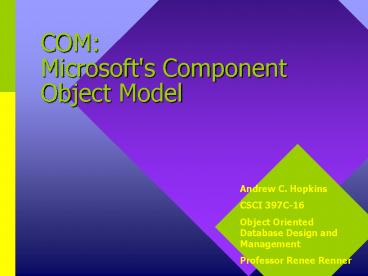COM: Microsoft's Component Object Model - PowerPoint PPT Presentation
1 / 11
Title:
COM: Microsoft's Component Object Model
Description:
Microsoft's Component Object Model (COM) provides a new methodology ... Distributed COM (DCOM) Conclusion (cont) Successfully used. Windows operating systems ... – PowerPoint PPT presentation
Number of Views:678
Avg rating:3.0/5.0
Title: COM: Microsoft's Component Object Model
1
COM Microsoft's Component Object Model
Andrew C. Hopkins CSCI 397C-16 Object Oriented
Database Design and Management Professor Renee
Renner
2
Introduction
- Microsofts Component Object Model (COM)
provides a new methodology for software
encapsulation, reuse, and versioning. - Derived from Microsofts Object Linking and
Embedding (OLE) technology.
3
Reasons For COM
- Distribution of library source code inefficient.
- Dynamic Link Libraries
- alleviated source code difficulties.
- Incompatible cross compiler support.
- Source code encapsulation, not binary
encapsulation.
4
Primary COM Techniques
- Interface programming.
- Supports binary layout and compatibility.
- Contains pure virtual functions and no members.
- Inherits from a single ancestor class.
- Sets the Virtual Table (VTBL).
5
Primary COM Techniques
- The interface, IUnknown.
- All interfaces must ultimately inherit from
Iunknown. - Three methods
- QueryInterface
- AddRef
- Release
6
Primary COM Techniques
- Reference counting
- AddRef increments the interior count.
- Release decrements the interior count.
- Object releases itself from memory when reference
count is 0. - Maybe per interface or per COM object.
7
COM Topics
- Class objects
- Creates COM components
- Apartments
- Handle single and multithreading concerns
- Servers
- Contains the binaries for the COM component.
8
COM Tools
- Microsofts native COM API
- Microsoft Foundation Classes (MFC)
- Microsofts Active Template Library (ATL)
9
Conclusion
- Many more COM topics and techniques.
- Interface Definition Language (IDL)
- Categories
- Automation
- Distributed COM (DCOM)
10
Conclusion (cont)
- Successfully used
- Windows operating systems
- Microsoft applications for Windows
- Third party developers writing for Windows OS
- Provides for fast, flexible, and reusable
software components
11
Works Cited
- Box, Don, Essential COM, Addison-Wesley
Publishing Company, Reading, Massachusetts, 1998. - Denning, Adam, ActiveX Controls Inside Out,
Second Edition, Microsoft Press, Redmond,
Washington, 1997. - Rogerson, Dale, Inside COM, Microsoft Press,
Redmond, Washington, 1997.































